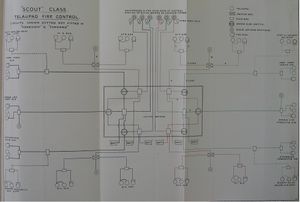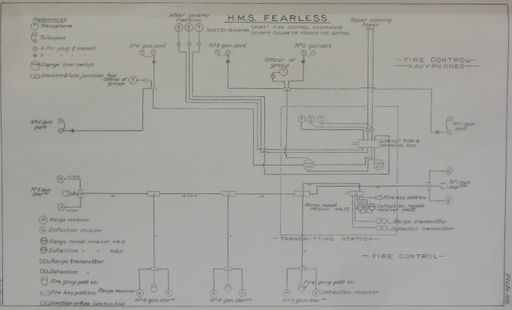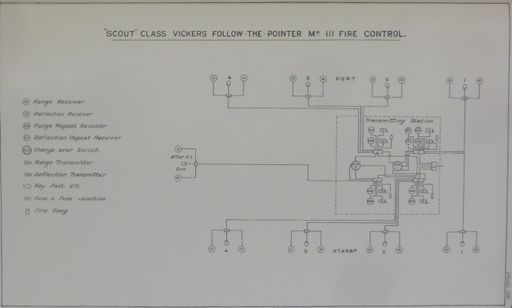Boadicea Class Cruiser (1908)
The seven scout cruisers of the Boadicea Class were completed at Pembroke Royal Dockyard between 1910 and 1913.
Today, the class is often treated as three separate classes (two Boadiceas, two Blondes and three Actives) but contemporary documents almost always seem to discuss them collectively.[1] There are, however some significant differences. Most notably, Boadicea and Bellona had just six 4-in guns, and the others carry eight or ten. The mountings also differ as indicated below.
Their designation as scout cruisers was taken literally, as Blanche, Blonde and Bellona served throughout the war providing a close-in screen to individual Battle Squadrons for fleet operations.
| Overview of 7 vessels | |||||
|---|---|---|---|---|---|
| Citations for this data available on individual ship pages | |||||
| Name | Builder | Laid Down | Launched | Completed | Fate |
| Boadicea | Pembroke Royal Dockyard | 1 Jun, 1907 | 14 May, 1908 | Jun, 1909 | Sold 13 Jul, 1926 |
| Bellona | Pembroke Royal Dockyard | 5 Jun, 1908 | 20 Mar, 1909 | Feb, 1910 | Sold 9 May, 1921 |
| Blonde | Pembroke Royal Dockyard | 6 Dec, 1909 | 22 Jul, 1910 | May, 1911 | Sold 6 May, 1920 |
| Blanche | Pembroke Royal Dockyard | 12 Apr, 1909 | 25 Nov, 1909 | Nov, 1910 | Sold 27 Jul, 1921 |
| Active | Pembroke Royal Dockyard | 27 Jul, 1910 | 14 Mar, 1911 | Dec, 1911 | Sold 21 Apr, 1920 |
| Amphion | Pembroke Royal Dockyard | 15 Mar, 1911 | 1911 | Mar, 1913 | Mined 6 Aug, 1914 |
| Fearless | Pembroke Royal Dockyard | 15 Nov, 1911 | 1912 | Oct, 1913 | Sold 8 Nov, 1921 |
Binoculars
In September 1914, the ships were allowed six additional pairs of Pattern 343 Service Binoculars.[2]
Habitability
In 1912 and 1913, four Bastian Radiators were obtained for a temporary trial in warming the Officers' Cabins on the Upper Deck where radiators were not already present. Based on the satisfactory reports, these radiators were kept in place permanently.[3]
Boats
The ships were ordered in July 1914 to surrender their 13.5 foot dinghy unless they'd already returned their Balsa Raft – they were not to carry both.[4]
Rangefinders
In January 1914, it was reported that a rangefinder mounted on the fore upper bridge may have been unable to work properly when the ships were steaming at high speeds. Whether this was due to vibration or spray is not made clear.[5] At the same time, it was worried that a rangefinder mounted aft had a forward arc of view obstructed by boats.[6]
In 1918, it was proposed that the "Blonde class" should have their existing 4.5 foot rangefinder replaced by a 9-foot model. It is not clear if this applies to just the Blonde group ships or this entire class.[7]
Armament
Guns
Boadicea
This section sourced from The Sight Manual, 1916[8] except as indicated.
- six 4-in B.L. Mark VII guns on P. IV mountings
The P. IV mountings could elevate to 15 degrees and depress to 10 degrees, but though its sight could match the 15 degree elevation, the range dial was only graduated to 8,500 yards (8.5 degrees) at 2,225 fps. This might have been in obeisance to the Admiralty's stated desire that giving a long-ranged gun to a light cruiser is a guarantee that it will go get in a gunfight and abandon its scouting duties.[Inference][Citation needed]
The gear-worked sights, the first F.T.P. models to be introduced, had a range gearing contant of 42.95 and spiral-reading range dials for 2850 fps, 1-in aiming rifle and .303-in aiming rifle. M.V. could be corrected (downward only) 200 fps by adjustable scale plate.
The deflection gearing constant was 61.7 with 1 knot equal to 2.74 arc minutes, corresponding to 2824 fps at 3500 yards. Drift was corrected by inclining the sight 2 degrees.
The layer's sight line was 16.8 inches above the bore, and 15 inches left. The trainer's lines were 16.8 inches above and 14.9 inches right.
The sight lacked a "C" corrector. A number of temperature scale plates corresponding to M.V.s varying by 25 fps could be shipped with an index facing the actual M.V..
Open sights do not seem to be in the drawing.
In October 1913, it was decided that the mountings should also have buzzer for their firing circuits.[9]
Bellona, Blonde and Blanche
This section sourced from The Sight Manual, 1916[10] except as noted.
- six (Bellona) or ten ((Blonde and Blanche) 4-in B.L. Mark VII guns on P. IV* mountings with F.T.P. sights.[11]
These ships had the same mountings as some Bristol class cruisers.
The mounting could elevate 15 degrees and depress 10 degrees, but though its sight could match the 15 degree elevation, the range dial was only graduated to 11.5 degrees (10,000 yards).
These cam-worked F.T.P. sights had range dials for 2750 fps, and 1-in and .303-in aiming rifles. M.V. could be corrected by adjustable pointer through +/- 150 fps.
The deflection gearing constant was 64.277 with 1 knot equal to 2.41 arc minutes, corresponding to 2800 fps at 2000 yards. Drift was corrected by inclining the sight 2 degrees.
The layer's sight line was 13.73 inches above the bore, and 15.85 inches left. The trainer's sight line was 15.08 inches above and 14.9 inches right.
The sight had a temperature correcting scale plate and a "C" corrector.
The layer had an open sight. The trainer's sight could be used as a free sight with a counterweight.
In August of 1913, Portsmouth Royal Dockyard was to supply head rests for these guns, to be fitted in the dockyard when the opportunity arose.[12] In October 1913, it was decided that the mountings should also have buzzer for their firing circuits.[13]
Active and Amphion
This section sourced from The Sight Manual, 1916[14] except as noted.
- ten 4-in B.L. Mark VII guns[15] on P. IV** mountings
The layer had a double-handed bicycle-type two-speed elevating crank. At high speed, it elevated the gun 2.97 degrees per rotation. At slow speed, it did 1.48 degrees. The right hand had a firing trigger right on the elevating handle, and the speed selection was made by throwing a separate lever using the left hand.[16] The pedestal had a lever to clamp the gun in training.[17]
The mounts could elevate 15 degrees and depress 10 degrees, but though the sights could match the 15 degree elevation, the range dials were only graduated to 11.5 degrees (10,000 yards).
These cam-worked sights had range dials for 2750 fps, and 1-in and .303-in aiming rifles. M.V. could be corrected by adjustable pointer through +/- 150 fps.
The deflection gearing constant was 64.277 with 1 knot equal to 2.41 arc minutes, corresponding to 2800 fps at 2000 yards. Drift was corrected by inclining the sight 2 degrees.
The layer's sight line was 13.73 inches above the bore, and 15.85 inches left. The trainer's sight line was 13.83 inches above and 14.9 inches right.
The sight had a temperature correcting scale plate and a "C" corrector.
These were likely F.T.P. sights, but there is no definite indication that they were.[Inference]
The layer had an open sight. The trainer's sight could be used as a free sight with a counterweight.
In August of that 1913, Portsmouth Royal Dockyard was to supply head rests for the guns on Active and Amphion, to be fitted by the ships' artificers.[18]
Fearless
This section is sourced from The Sight Manual, 1916.[19]
- ten (possibly just eight when completed) 4-in B.L. Mark VII guns on P. VIII mountings with F.T.P. sights.
The mounts could elevate 15 degrees and depress 10 degrees, but though the sights could match the 15 degree elevation, the range dials were only graduated to 14 degrees (11,000 yards). It appears that no other ships carried this particular mount.
These cam-worked sights had range dials for 2750 fps, and 1-in and .303-in aiming rifles. M.V. could be corrected by adjustable pointer through +/- 150 fps.
The deflection gearing constant was 59.79 with 1 knot equal to 2.41 arc minutes, corresponding to 2750 fps at 2000 yards. Drift was corrected by inclining the sight bracket 2 degrees.
The layer's sight line was 12 inches above the bore, and 22.3 inches left. The trainer's sight line was 12 inches above and 18.25 inches right.
In addition to the M.V. corrector, the sight had a temperature correcting scale plate and a "C" corrector.
There was an open sight on both sides. No mention is made of a free sight.
Torpedoes
The two ships ordered in the 1908-09 Programme had smaller torpedoes.[20]
- two 18-in torpedo tubes
Other vessels:
- two 21-in torpedo tubes.
Fire Control
Control Groups

In 1909, these were described as being similar to the Gem class, but the forecastle and poop guns could be controlled as separate groups or attached to the nearest broadside group on either side. The middle line guns could be connected to whichever side was desired.[22] However, the figure shown indicates that the guns were grouped with the first three on each broadside being in a forward group and the aftmost pair being the aft group for navyphone control with no similar provision being offered for data circuits.
Torpedo Control
In 1907, Boadicea, Swift and the River class destroyers were to be equipped with Fore Bridge Firing Gear.[23] Later, it was decided that Bellona, Blanche and Blonde would not receive Fore Bridge Firing Gear.[24]
Transmitting Stations
If we trust that they all resembled Fearless, they had a transmitting station forward.[25]
Dreyer Table
These ships had no fire control tables.[26]
Fire Control Instruments

Boadicea Group
By 1909, Boadicea (Mark I instruments) and Bellona (Mark II) were outfitted with Vickers F.T.P. Fire Control Instruments, marking a new wrinkle in equipment by replacing the Barr and Stroud equipment that had taken hold shortly after 1906. The equipment was fitted as follows:[28][29]
- Range Transmitters: 3
- Deflection Transmitters: 3
- Range Receivers: 6
- Deflection Receivers: 6
- C.O.S.: 1
- Vickers Fire Gongs: 6 with 3 keys
Neither ship had Target Visible or Gun Ready signals.[30]
Blonde Group
In 1909, it was planned that Blonde and Blanche were to be completed with the latest Vickers Mark II F.T.P. Fire Control Instruments as follows:[31][32]
- Range Transmitters: 2
- Deflection Transmitters: 2
- Range Receivers: 10
- Deflection Receivers: 10
- C.O.S.: none
- Vickers Fire Gongs: 10 with 2 keys
Neither ship had Target Visible or Gun Ready signals.[33]
Active Group

Control was by navyphone from either:[37]
- Aft control platform
- Upper conning tower
The upper conning tower position may have been a fall-back, as its portable navyphones could also be plugged in at the T.S..
The navyphone control could split fire in fore and aft groups. The data system for each broadside had only a single set of transmitters and not C.O.S. in the T.S. and could not.
Each broadside had similar, separate systems along the following pattern. Each had a Pattern 872 firing key in the T.S. to actuate the Pattern 872 firing gongs at the guns, and range and deflection transmitters (with local Mark III repeats) to drive the receivers at the guns. There were no C.O.S. fitted to allow the splitting of these data connections into fore/aft groups as was provided for the navyphone system.[38] Confusingly, the next plate in the same source indicates that the data systems did have a C.O.S. to permit fore-aft splitting, with four sets of transmission gear in the T.S..[39]
Alterations
By November 1918, Boadicea, Bellona, Blonde and Blanche were fitted with rails for 66 mines. The torpedo tubes and guns removed when the mines were shipped could be placed back aboard with enough notice.[40]
See Also
Footnotes
- ↑ For instance, Monthly Supplement to the Navy List (November, 1915) p. 25.
- ↑ Admiralty Weekly Order No. 331 of 8 Sep, 1914.
- ↑ Admiralty Weekly Order No. 600 of 24 October 1913.
- ↑ Admiralty Weekly Order No. 131 of 10 July 1914.
- ↑ Admiralty Weekly Order No. 790 of 9 Jan, 1914.
- ↑ Admiralty Weekly Order No. 791 of 9 Jan, 1914.
- ↑ Annual Report of the Torpedo School, 1918. p. 179. (G. 36364/18).
- ↑ The Sight Manual. 1916. pp. 7, 87, 108, Plate 40.
- ↑ Admiralty Weekly Order No. 569 of 17 Oct, 1913.
- ↑ The Sight Manual. 1916. pp. 86, 108, Plate 39.
- ↑ The Sight Manual. 1916. p. 86.
- ↑ Admiralty Weekly Order No. 470 of 22 Aug, 1913.
- ↑ Admiralty Weekly Order No. 569 of 17 Oct, 1913.
- ↑ The Sight Manual. 1916. pp. 86, 108, Plate 39.
- ↑ The Technical History and Index, Vol. 4, Part 36. p. 4.
- ↑ Handbook for 4-in Mark VII & VIII B.L. Guns, 1916.. Plate 32.
- ↑ Handbook for 4-in Mark VII & VIII B.L. Guns, 1916.. Plate 31.
- ↑ Admiralty Weekly Order No. 470 of 22 Aug, 1913.
- ↑ The Sight Manual. 1916. pp. 81-82, 108, Plate 35.
- ↑ Dittmar; Colledge. British Warships 1914–1919. p. 45.
- ↑ Handbook for Fire Control Instruments, 1909. Plate 54.
- ↑ Handbook for Fire Control Instruments, 1909. pp. 51-52.
- ↑ Annual Report of the Torpedo School, 1907. p. 31. Its design was detailed in Annual Report of the Torpedo School, 1906, p. 28.
- ↑ Annual Report of the Torpedo School, 1909. p. 33.
- ↑ Handbook for Fire Control Instruments, 1914. Plate 100.
- ↑ Handbook of Captain F. C. Dreyer's Fire Control Tables, 1918. p. 3.
- ↑ Handbook for Fire Control Instruments, 1909. Plate 52.
- ↑ Handbook for Fire Control Instruments, 1909. pp. 57, 60.
- ↑ Annual Report of the Torpedo School, 1909. p. 148.
- ↑ Handbook for Fire Control Instruments, 1914. p. 11.
- ↑ Handbook for Fire Control Instruments, 1909. pp. 57, 60.
- ↑ Annual Report of the Torpedo School, 1909. p. 148.
- ↑ Handbook for Fire Control Instruments, 1914. p. 11.
- ↑ Handbook for Fire Control Instruments, 1914. Plate 100. Though this is said to apply to Fearless, the ten guns hints it applies to Active and Amphion..
- ↑ Handbook for Fire Control Instruments, 1914. Plate 101.
- ↑ Handbook for Fire Control Instruments, 1914. p. 66 Though this is said to apply to Scout, the source indicates it applies to the "Fearless class".
- ↑ Handbook for Fire Control Instruments, 1914. Plate 100.
- ↑ Handbook for Fire Control Instruments, 1914. Plate 100.
- ↑ Handbook for Fire Control Instruments, 1914. Plate 101.
- ↑ Annual Report of the Torpedo School, Mining Appendix, 1917-18. p. 11. Plate 7.
Bibliography
- Admiralty, Gunnery Branch (1910). Handbook for Fire Control Instruments, 1909. Copy No. 173 is Ja 345a at Admiralty Library, Portsmouth, United Kingdom.
| Boadicea Class Scout Cruiser | |||||||||||||||||||||||||||||||||||||||||||||||||||||||||||||||||||||||||||||||||||||||||||||||||||||||||||||||||||||||
| Boadicea Group | |||||||||||||||||||||||||||||||||||||||||||||||||||||||||||||||||||||||||||||||||||||||||||||||||||||||||||||||||||||||
| Boadicea | Bellona | ||||||||||||||||||||||||||||||||||||||||||||||||||||||||||||||||||||||||||||||||||||||||||||||||||||||||||||||||||||||
| Blonde Group | |||||||||||||||||||||||||||||||||||||||||||||||||||||||||||||||||||||||||||||||||||||||||||||||||||||||||||||||||||||||
| Blonde | Blanche | ||||||||||||||||||||||||||||||||||||||||||||||||||||||||||||||||||||||||||||||||||||||||||||||||||||||||||||||||||||||
| Active Group | |||||||||||||||||||||||||||||||||||||||||||||||||||||||||||||||||||||||||||||||||||||||||||||||||||||||||||||||||||||||
| Active | Amphion | Fearless | |||||||||||||||||||||||||||||||||||||||||||||||||||||||||||||||||||||||||||||||||||||||||||||||||||||||||||||||||||||
| <– | Sentinel Class | Minor Cruisers (UK) | Bristol Class | –> | |||||||||||||||||||||||||||||||||||||||||||||||||||||||||||||||||||||||||||||||||||||||||||||||||||||||||||||||||||
